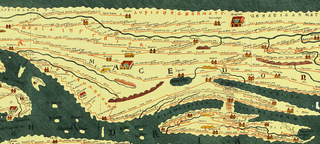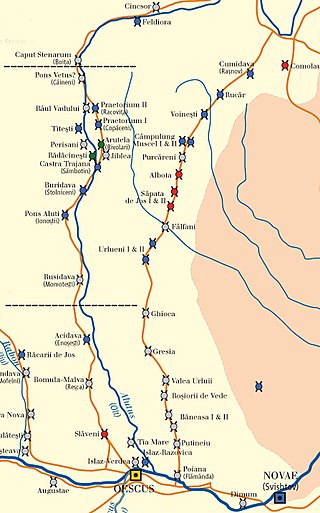
Amutria was a Dacian town close to the Danube and included in the Roman road network, after the conquest of Dacia.

Ad Mutriam was a fort in the Roman province of Dacia in the 2nd century AD.

Jidava was a fort in the Roman province of Dacia 4 km southwest of the town of Campulung, Romania. It was built around 190–211 AD as part of the frontier system of the Limes Transalutanus located approximately 20 km south of the Rucÿr-Bran pass.
The fort was part of the defensive system of the Roman province of Dacia in the 2nd and 3rd centuries AD. The ruins of a contemporary nearby defensive ditch was also unearthed. It is located in Abrud (Romania).

The Castra of Albota was a castrum in the province of Dacia. It was built after 161 AD as part of the Limes Transalutanus.
The castra of Poiana was a fort in the Roman province of Dacia near the present town of Poiana. It was built in the 2nd century AD and abandoned in the next century. It was a part of the Limes Transalutanus frontier system and situated at the southern end next to the Danube.

The castra of Hoghiz was a fort in the Roman province of Dacia. The fort was built in the 2nd century AD, on the left bank of the Olt River, at a place where a Dacian settlement existing already in the 2nd century BC was unearthed. The fort and the nearby village were abandoned in the 3rd century AD. The ruins of the castra are located in Hoghiz, Romania.

The Castra of Ighiu was a fort made of earth in the Roman province of Dacia. Its dating is uncertain. The traces of the earthwork can be identified on the Măguligici Hill in Ighiu (Romania).

The castra of Orheiu Bistriței was a fort in the Roman province of Dacia. It was built in the 2nd century AD. Archaeological research also identified the nearby vicus. The castra and the nearby settlement were both abandoned in the 3rd century AD. The ruins of the fort are located in Orheiu Bistriței.
It was a fort in the Roman province of Dacia and part of the Roman frontier system of the Limes Transalutanus.
The castra of Crâmpoia was a fort in the Roman province of Dacia. It was made of earth in the 2nd century AD. The Romans abandoned the fort in the 3rd century. Its ruins are located in Crâmpoia, Romania.
The castra of Costești was a fort in the Roman province of Dacia. Erected and abandoned by the Romans at an uncertain date, its ruins are located in Costești on a hilltop, at an altitude of 1203 meters.

The castra of Târsa was a temporary fort erected by the Romans during the Trajan's Dacian Wars.

Apulum was a legionary fortress in the Roman province of Dacia from the 2nd to 4th centuries AD, located in today's Alba Iulia, Romania.

Gresia Roman fort is located in the present Gresia. It was in the Roman province of Dacia and dates from the 2nd and 3rd centuries AD. It was part of the frontier system of the Limes Transalutanus.
The castra of Livezile was a castra in the Roman province of Dacia, located in the north side of the modern commune of Livezile in the historical region of Transylvania, Romania. The fort was erected and surrounded by a ditch in the 2nd century AD. The castra was abandoned in the 3rd century and its ruins are still visible.
The castra of Pinoasa was a fort in the Roman province of Dacia. Matei Dan dates the castra to the period of the Dacian Wars. Its ruins were destroyed by excavations at the Rovinari Coal Mine.

Castra of Titești was a fort in the Roman province of Dacia near the Limes Alutanus on the west bank of the Olt River.

In Roman Dacia, an estimated 50,000 troops were stationed at its height.
This page is based on this
Wikipedia article Text is available under the
CC BY-SA 4.0 license; additional terms may apply.
Images, videos and audio are available under their respective licenses.









